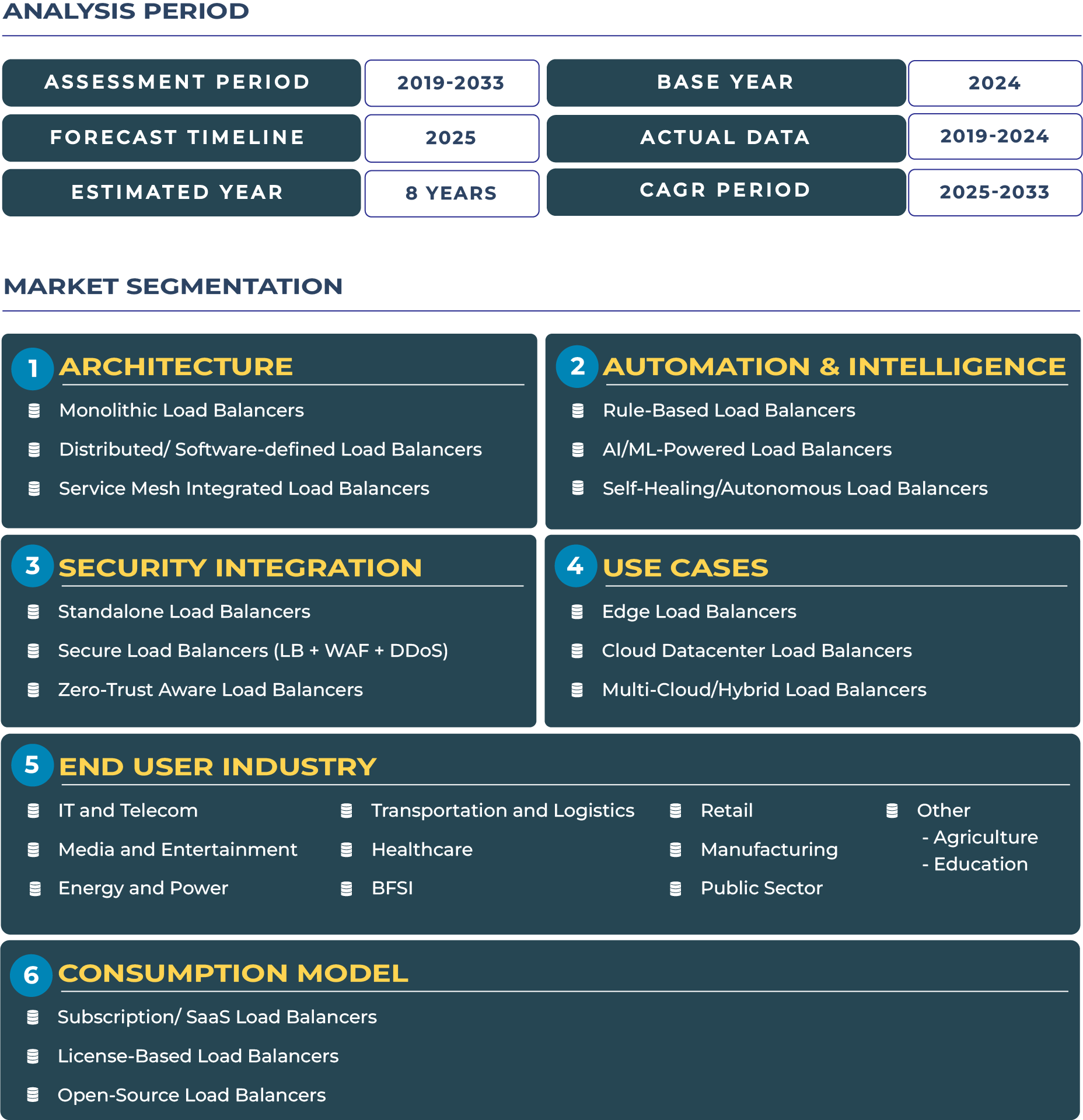Report Format:
![]()
![]() |
Pages: 110+
|
Pages: 110+
Kenya Cloud Load Balancers Market: East Africa’s Startup and Fintech Growth Engine
Kenya has earned a reputation as East Africa’s innovation hub, with its fintech ecosystem led by M-Pesa and a vibrant startup culture in Nairobi. This dynamic ecosystem is fueling demand for scalable, secure, and high-performing digital infrastructure. At the center of this evolution lies the Kenya cloud load balancers market, a critical enabler of reliable digital experiences across fintech, SMEs, and government e-services. In 2025, the sector is expected to generate USD 3.1 million, and by 2033, it is forecast to reach USD 11.7 million, reflecting a robust CAGR of 18.3% (DataCube Research). This trajectory underscores Kenya’s expanding reliance on distributed and service mesh integrated load balancers that ensure secure, seamless, and resilient cloud adoption for enterprises of all sizes.
Kenya Cloud Load Balancers Market Outlook: Why Cloud Load Balancers Are Becoming a Digital Lifeline in Kenya
Kenya’s market outlook for cloud load balancers is closely tied to its fintech-driven digital ecosystem, where financial inclusion has become a global benchmark. The role of cloud infrastructure in maintaining uptime for millions of daily mobile transactions is critical, and load balancers have become the foundation of this resilience. Nairobi, recognized as the region’s Silicon Savannah, continues to attract international investors and multinational cloud service providers, amplifying demand for scalable digital infrastructure. Additionally, government-led digitization programs supported by the Ministry of Information, Communications and the Digital Economy are reinforcing adoption across healthcare, education, and administrative services. This combination of grassroots fintech usage and top-down digital strategies explains why the market is accelerating, despite infrastructure gaps in semi-urban and rural areas. Kenya’s trajectory highlights cloud load balancers not only as a growth enabler but also as a safeguard for national digital reliability.
Drivers & Restraints: Balancing Catalysts and Barriers in Kenya Cloud Load Balancers Industry
Mobile Money and Startup Momentum as Growth Catalysts
Kenya’s role as a mobile money pioneer has amplified reliance on cloud-native infrastructure. M-Pesa alone processes billions of transactions annually, demanding highly scalable load balancing solutions to ensure transaction security and uninterrupted services. Simultaneously, Nairobi’s expanding startup ecosystem, spanning e-commerce, health-tech, and logistics, is fueling demand for distributed and software-defined load balancers that provide cost-effective scalability. Recent investments in regional data centers, including submarine cable landings on the Kenyan coast, further enhance the capacity for cloud adoption and strengthen the foundation of the cloud load balancers ecosystem.
Infrastructure Limitations and Regulatory Variability as Constraints
While the opportunities are vast, Kenya faces systemic barriers that may slow adoption. Infrastructure gaps outside urban centers limit cloud penetration in rural regions where digital demand is rising. Budgetary restrictions among SMEs also hinder adoption of advanced load balancing solutions, often pushing them toward low-cost or manual alternatives. Moreover, regulatory variability, including shifts in data protection and localization rules, adds uncertainty for global providers entering Kenya. These constraints highlight the dual need for affordable solutions and clear regulatory frameworks to ensure long-term market sustainability.
Trends & Opportunities: Kenya Cloud Load Balancers Sector at the Intersection of Fintech and Telecom Innovation
Fintech Expansion and Government e-Services Fueling Market Trends
Kenya’s fintech ecosystem continues to shape demand for advanced load balancing capabilities. The digitization of public services, including healthcare record systems and tax platforms, has further highlighted the importance of reliable cloud distribution. Telco-edge initiatives by operators such as Safaricom are enabling edge PoPs that bring cloud closer to end-users, reducing latency and supporting high-traffic fintech and e-commerce platforms. Managed service providers (MSPs) are also playing a pivotal role by helping SMEs deploy service mesh integrated load balancers at affordable cost models.
Opportunities in Telco Partnerships and Low-Cost SaaS Models
The market presents significant opportunities for players willing to align with local realities. Managed load balancer services tailored to fintechs and government workloads can accelerate adoption. Telco partnerships offer ready-made distribution networks to extend reach, while SaaS-based low-cost load balancing solutions are opening doors for small businesses seeking scalable infrastructure without prohibitive costs. These opportunities ensure that the Kenya cloud load balancers sector is not only advancing technologically but also becoming more inclusive, bridging the affordability gap across different enterprise sizes.
Competitive Landscape: Strategies and Alliances Reshaping Kenya’s Cloud Load Balancers Ecosystem
The competitive dynamics of Kenya cloud load balancers landscape are being reshaped by a mix of international and local players. Global giants like Microsoft Azure and Amazon Web Services are scaling operations in Nairobi through regional partnerships, while local providers and MSPs are aligning with telecom leaders such as Safaricom to deliver distributed and managed services. These strategies, focused on fintech-first go-to-market models and MSP-led delivery, resonate with Kenya’s strongest adopters: SMEs and financial platforms. In addition, strategic initiatives such as data localization compliance and telco-driven edge deployments are creating differentiation for players in the market. With growing emphasis on security-first innovation, distributed and service mesh integrated load balancers are poised to dominate the competitive landscape over the next decade.







